In today's ever-evolving digital landscape, the integration of machine learning (ML) into various aspects of business operations is becoming increasingly ubiquitous. Organizations are leveraging ML for a wide array of applications, from predictive analytics to fraud detection, and even threat analysis. Amid this rapid adoption, the realm of Machine Learning Security Operations, or MLSecOps, is emerging as a pivotal concern for CEOs, CIOs, and CMOs.
The MLSecOps Imperative

The vast potential of machine learning models is undeniable, but it comes with an equal measure of vulnerability. As businesses entrust their decision-making processes and operations to ML models, the need to secure these models from malicious actors becomes paramount. The stakes are high – a compromised ML model can result in data breaches, financial losses, and significant damage to a company's reputation.
In this comprehensive guide, we will delve into the intricacies of MLSecOps and explore why having a dedicated team for securing machine learning models is no longer a luxury but a necessity. We'll discuss the ever-present threats such as adversarial attacks, model poisoning, and data poisoning, and provide insights into methods for evaluating model robustness and techniques to protect ML models from exploitation. So, let's embark on this journey to understand the significance of MLSecOps and how it can ensure the reliability and integrity of your machine learning endeavors.
Understanding the Threat Landscape
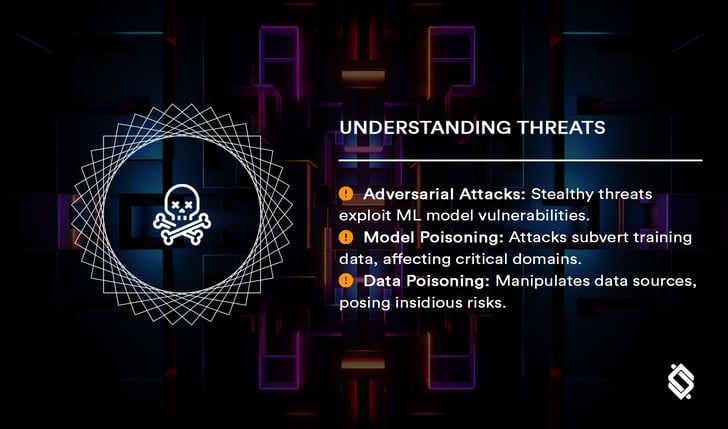
Adversarial Attacks: The Stealthy Predators
Adversarial attacks are akin to silent intruders in the world of machine learning. These attacks are cunningly designed to exploit vulnerabilities in ML models, resulting in incorrect predictions or classifications. They can have far-reaching consequences, from manipulating recommendations on e-commerce platforms to compromising the accuracy of autonomous vehicles' perception systems.
A Closer Look
Adversarial attacks involve the introduction of subtly perturbed inputs to an ML model, leading it to make erroneous predictions. These perturbations, often imperceptible to human observers, can trick the model into misclassifying objects, texts, or any data it processes. For instance, consider an image recognition system that misidentifies a stop sign as a speed limit sign when exposed to a carefully crafted adversarial image.
The MLSecOps Solution
To counter adversarial attacks, an MLSecOps team employs robustness techniques such as adversarial training and defensive distillation. Regularly updating models to identify and defend against new attack patterns is essential to maintain the security of ML systems.
Model Poisoning: The Subversion of Trust
Model poisoning attacks target the training data of an ML model, subtly introducing malicious data points. These poisoned data points are then used to train the model, causing it to make incorrect predictions or recommendations. The subversion of training data can have profound implications, especially in critical domains like healthcare and finance.
A Closer Look
Imagine a recommendation system for medical treatment. If an attacker injects fraudulent patient records into the training data, the model might start recommending inappropriate treatments, endangering patient lives. Model poisoning can also be employed to compromise fraud detection systems, causing them to approve fraudulent transactions.
The MLSecOps Solution
MLSecOps teams focus on data quality and implementing robust training data validation protocols. Detecting and mitigating model poisoning attacks require proactive measures to ensure the integrity of training data, including anomaly detection and outlier removal.
Data Poisoning: The Tainted Wellspring
Data poisoning attacks go beyond model poisoning by targeting the data sources themselves. Attackers manipulate the data collection process, injecting tainted data from the ground up. This can be particularly insidious because it infects the very source of an ML model's learning.
A Closer Look
Consider a spam email filter trained on user-generated content. Attackers could submit malicious emails designed to look benign, infiltrating the filter's training data with harmful examples. As a result, the filter may start to overlook actual spam emails, causing an inundation of unwanted content in users' inboxes.
The MLSecOps Solution
MLSecOps teams must ensure the integrity of data sources through rigorous data validation processes. Techniques such as data provenance tracking and source authentication can help identify and eliminate tainted data before it contaminates the ML models.
Evaluating Model Robustness
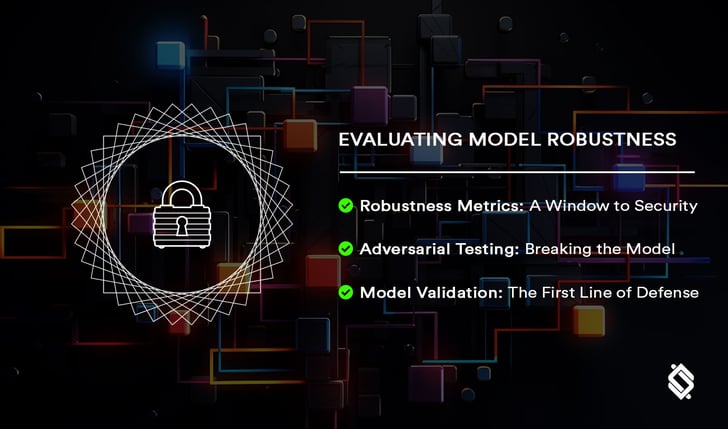
Robustness Metrics: A Window to Security
Evaluating the robustness of an ML model is the cornerstone of MLSecOps. Robustness metrics provide insights into a model's susceptibility to attacks and its overall reliability. These metrics serve as a litmus test to assess a model's vulnerability.
A Closer Look
Robustness metrics include measures like adversarial accuracy, fooling rates, and false positive rates. Adversarial accuracy quantifies how well a model performs under adversarial conditions, while fooling rates gauge the model's susceptibility to adversarial examples. False positive rates assess the model's propensity to make incorrect predictions.
The MLSecOps Solution
MLSecOps teams employ a range of techniques to enhance model robustness. This includes leveraging robust training datasets, using ensemble methods, and implementing model compression techniques. These strategies help to reduce vulnerabilities and enhance the model's resilience to attacks.
Adversarial Testing: Breaking the Model
Evaluating the robustness of an ML model is the cornerstone of MLSecOps. Robustness metrics provide insights into a model's susceptibility to attacks and its overall reliability. These metrics serve as a litmus test to assess a model's vulnerability.
A Closer Look
Adversarial testing encompasses a spectrum of attacks, from basic to highly sophisticated. Examples include gradient-based attacks, transfer attacks, and black-box attacks. These tests provide valuable insights into the model's weaknesses and help MLSecOps teams tailor their defense strategies.
The MLSecOps Solution
Regular adversarial testing is a crucial element of MLSecOps. It allows organizations to discover and patch vulnerabilities before they can be exploited by malicious actors. By subjecting models to a variety of adversarial scenarios, teams can iteratively improve their robustness.
Model Validation: The First Line of Defense
Model validation is an essential step in MLSecOps. It ensures that an ML model performs as expected in real-world conditions. This includes validating the model's accuracy, reliability, and security.
A Closer Look
Validation processes involve extensive testing to uncover potential issues. This includes validation of model inputs, outputs, and the overall system performance. In MLSecOps, the focus is on not only traditional validation but also security validation to detect vulnerabilities.
The MLSecOps Solution
Model validation in MLSecOps incorporates techniques like stress testing and security analysis. By simulating real-world scenarios and potential attacks, organizations can identify and address security weaknesses before they become exploitable threats.
Protecting ML Models from Exploitation
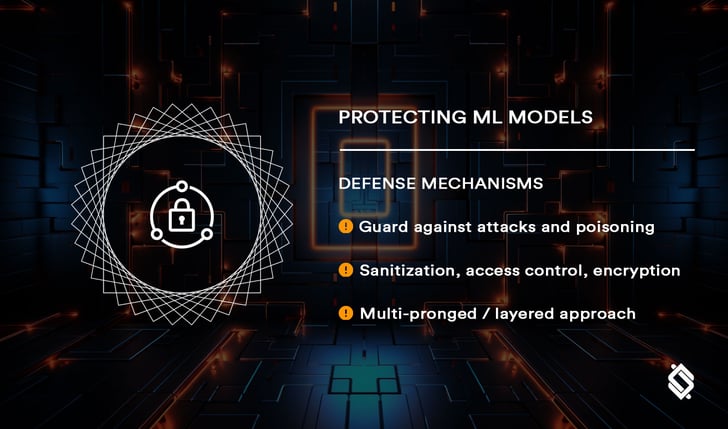
Defense Mechanisms: Armor for Your Models
Protecting ML models from exploitation requires the implementation of robust defense mechanisms. These mechanisms act as the first line of defense against potential threats, including adversarial attacks and model poisoning.
A Closer Look
Defense mechanisms include techniques like input sanitization, access controls, and encryption. Input sanitization helps filter out potentially harmful data before it reaches the model. Access controls limit who can interact with the model, reducing the risk of unauthorized access. Encryption secures data both at rest and in transit, safeguarding it from prying eyes.
The MLSecOps Solution
MLSecOps teams take a multi-pronged approach to defense. By implementing a combination of these mechanisms, they create a layered defense system that mitigates risks at various points of interaction with the model.
Anomaly Detection: Spotting Intruders
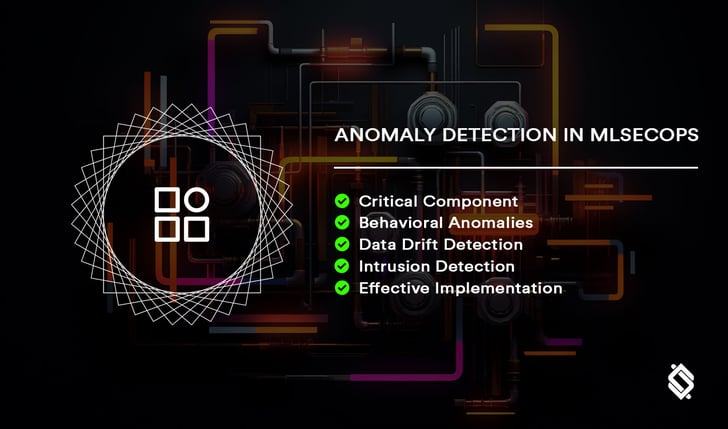
Anomaly detection is a critical component of MLSecOps. It involves monitoring the behavior of ML models and data sources to identify unusual or suspicious activities. This is especially important in identifying attacks and unauthorized access.
A Closer Look
- Behavioral Anomalies: In the context of ML models, behavioral anomalies can manifest as unusual patterns in data inputs, model responses, or system usage. For example, a sudden spike in model input that exceeds expected bounds or a substantial increase in model latency can be indicative of an anomaly. Behavioral anomalies can be early warning signs of attacks or system malfunctions.
- Data Drift Detection: Data drift, the gradual change in the statistical properties of input data, is a common concern in ML operations. Anomaly detection helps identify shifts in data distribution that can adversely affect model performance. It's essential to spot these drifts early to retrain models and maintain their accuracy.
- Intrusion Detection: Beyond model behavior, anomaly detection plays a vital role in identifying unauthorized access attempts or intrusions into the ML system. Suspicious login attempts, unexpected system access, or unusual data retrieval patterns can trigger alerts, allowing the MLSecOps team to take immediate action.
The MLSecOps Solution
To effectively implement anomaly detection within your MLSecOps strategy, consider the following steps:
- Baseline Establishment: Begin by establishing a baseline of normal behavior for your ML models and data sources. This baseline serves as a reference point against which anomalies are detected. It involves collecting historical data, understanding typical model performance, and monitoring system usage patterns.
- Continuous Monitoring: Anomaly detection is not a one-time effort. Continuous monitoring is essential to keep pace with the evolving threat landscape and changing data distributions. Implement real-time or periodic monitoring of model behavior and data sources.
- Alerting Mechanisms: Develop robust alerting mechanisms that trigger notifications when anomalies are detected. Alerts should be routed to the MLSecOps team for investigation and timely response. It's crucial to set alert thresholds carefully to avoid overwhelming the team with false positives.
- Machine Learning in Anomaly Detection: Consider leveraging machine learning techniques, including unsupervised learning and time-series analysis, to detect anomalies effectively. These methods can adapt to changing patterns and identify anomalies that might be challenging to define with rule-based approaches.
- Incident Response Plan: Prepare a well-defined incident response plan that outlines the steps to take when an anomaly is detected. This plan should involve isolating affected components, mitigating the impact, investigating the root cause, and implementing preventive measures to avoid future anomalies.
By integrating anomaly detection into your MLSecOps strategy, you can proactively identify and respond to potential threats and system irregularities. Early detection minimizes the impact of security breaches, data drift, and other anomalies, ensuring the reliability and integrity of your machine learning operations.
Building an Effective MLSecOps Team
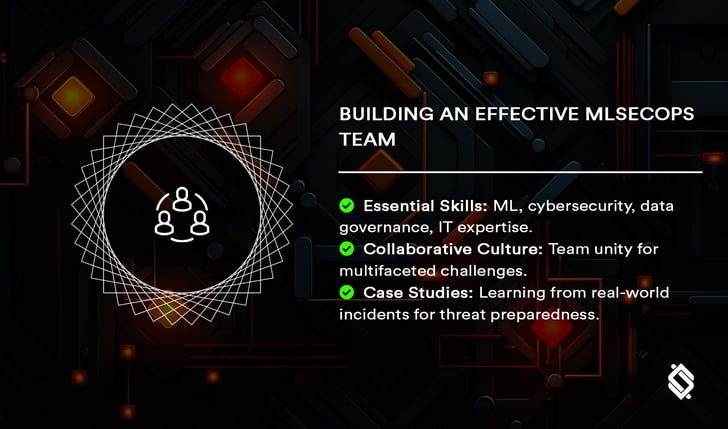
An MLSecOps team is the linchpin of your organization's machine learning security. Here, we delve into the composition and essential skills required to build an effective team dedicated to safeguarding your ML models and data.
The Essential Skill Set
- Machine Learning Expertise: The team should comprise experts in machine learning with a deep understanding of ML algorithms, model development, and evaluation. This expertise is vital for identifying vulnerabilities and implementing robust models.
- Cybersecurity Knowledge: Security professionals with knowledge of cybersecurity principles, including threat analysis, intrusion detection, and encryption, are crucial to protect ML systems from adversarial attacks and data breaches.
- Data Governance Specialists: Data governance experts are essential to ensure data quality, integrity, and compliance with privacy regulations. They play a pivotal role in data validation and preventing data poisoning.
- DevOps and IT Skills: Consider leveraging machine learning techniques, including unsupervised learning and time-series analysis, to detect anomalies effectively. These methods can adapt to changing patterns and identify anomalies that might be challenging to define with rule-based approaches.
Collaborative Culture: A Unified Front
Collaboration is the cornerstone of a successful MLSecOps team. A unified front, where team members from different disciplines work together seamlessly, is essential. Regular communication, knowledge sharing, and cross-training ensure that the team is well-prepared to tackle the multifaceted challenges of ML security.
Case Studies: Learning from the Past
Learning from real-world case studies is invaluable for MLSecOps teams. Analyzing past security incidents, understanding the attack vectors, and dissecting the response strategies can provide practical insights and best practices. These case studies serve as educational tools and help teams anticipate and mitigate future threats.
The Future of MLSecOps
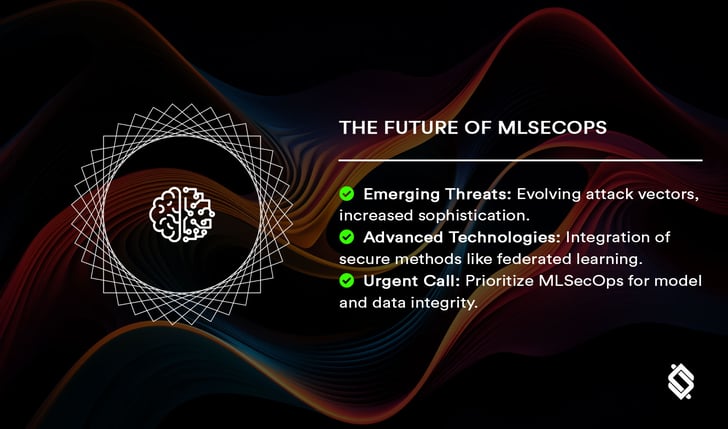
As MLSecOps continues to evolve, the landscape of machine learning security faces both challenges and opportunities. Here, we look ahead to the future of MLSecOps and what lies on the horizon.
Emerging Threats
The threat landscape is dynamic, with new attack vectors and techniques continually emerging. In the future, MLSecOps teams must remain vigilant against threats such as model inversion attacks, membership inference attacks, and backdoor attacks, which may become more sophisticated and prevalent.
Leveraging Advanced Technologies
The future of MLSecOps will see the integration of advanced technologies such as federated learning, secure multi-party computation, and homomorphic encryption. These technologies enable secure, privacy-preserving machine learning, making it harder for attackers to compromise models or access sensitive data.
The Call to Action
The call to action for CEOs, CIOs, and CMOs is clear: MLSecOps is not an option but a necessity. The reliability and integrity of your machine learning models and data are paramount to the success of your organization. By prioritizing MLSecOps, you can confidently embrace the transformative power of machine learning while safeguarding against evolving threats.
Conclusion: The Path Forward

As we conclude our exploration of MLSecOps and the critical role it plays in securing machine learning models, it's evident that the digital landscape is evolving at a relentless pace. As machine learning continues to transform industries and empower organizations with data-driven decision-making, the need for an MLSecOps team has never been more pronounced.
With a comprehensive understanding of the threat landscape, evaluation of model robustness, and deployment of protective measures, your organization can bolster its defenses against adversarial attacks, model poisoning, and data poisoning. Building a skilled MLSecOps team, fostering a collaborative culture, and learning from real-world case studies will be instrumental in fortifying your security posture.
The future of MLSecOps holds both challenges and opportunities. Emerging threats are on the horizon, but so are advanced technologies and techniques to combat them. It's a call to action for CEOs, CIOs, and CMOs to prioritize MLSecOps as an integral part of their strategic initiatives, ensuring the reliability and integrity of their machine learning endeavors.
In this age of data-driven decision-making, securing your machine learning models is not an option but a mission-critical imperative. MLSecOps is the key to unlocking the full potential of machine learning while safeguarding your organization against threats that lurk in the digital shadows. Stay vigilant, stay secure, and embrace the power of MLSecOps. Your future depends on it.



